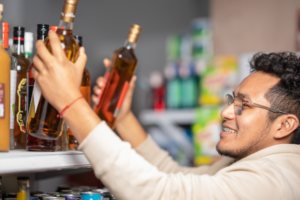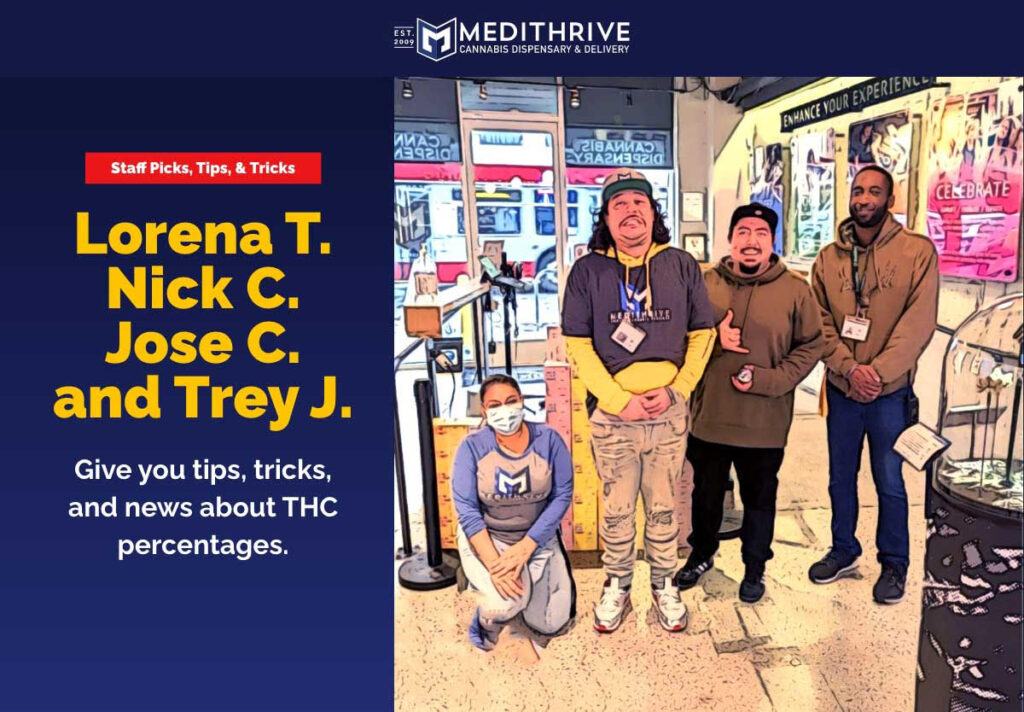High THC Percentages: The real reason behind those sky-high cannabis THC levels
A Journey from 25% to 47%
by Jose C.
In 2019, when I first stepped into the cannabis industry, the average THC content in flowers was around 25%. Over the years, I’ve witnessed THC percentages skyrocket to an astounding 47%.
Interestingly, the higher the THC content, the faster the flower sold, regardless of its price tag. Our team at MediThrive and many other experts in the cannabis industry think this is because customers were being told that higher THC levels meant a stronger high.
But that couldn’t be farther from the truth! (And we will get more into that as we dive deeper into this mystery.)

The Alcohol Analogy
When I visit a liquor store, I don’t reach for grain alcohol simply because it boasts the highest alcohol content. Instead, I choose a bottle or case of something I enjoy.
In fact, sometimes too high an alcohol percentage can make it hard to enjoy. Unfortunately, this mentality hasn’t translated to the cannabis market.
The Focus on High THC Percentages
When the legal market opened up in California, THC was one of the few lab results required to be printed on packaging. As a result, customers, budtenders, and brand representatives began to focus on the limited information provided:
-
THC percentage
-
Strain name
-
Brand
There was no requirement to print the genetics or lineage of the flower or the terpene content. But that’s what matters most!
The Aftermath
Dispensaries couldn’t keep high-testing flowers on their shelves. Brands and manufacturers took note and began rejecting low-testing flowers. Labs that consistently reported high THC levels saw an increase in business from brands and manufacturers.
Overall, the cannabis industry faced a shift towards prioritizing potency over quality, leading to increased competition among dispensaries, brands, and labs. With consumers demanding potent products, the pressure was on for all players to deliver top-tier cannabis products.

The Realization and Regulation
Industry insiders and scientists began to question the inflated numbers. Class action lawsuits started to hit the industry.
The Department of Cannabis Control (DCC) and other regulatory bodies took note and implemented standardized testing that took effect on January 1st this year.
The Current Scenario
Now, flowers that were once consistently testing at 35%+ are at more realistic levels. Customers are upset, confused, and continuously asking if a new high-THC batch of their favorite flower is back in stock yet.
The Lab Perspective
Inflated THC numbers surprised lab owners, according to a 2022 article. “Anything over 40%, you’re starting to get into crazy territory,” one said. “I’ve seen labs reporting 47% THC flowers, and I would say that’s highly suspect.”
The Regulatory Standpoint
At the beginning of 2024, the majority of testing labs were non-compliant with new testing regulations on dried flower. The ultimate goal for DCC regulators following the passage of S.B. 554 was to create standardized testing regulations that protect public health and safety.
“One of the challenges we face in regulating an industry that is not federally recognized is the lack of standardized and validated methods for testing,” said department Director Nicole Elliott in July 2022.
The Consumer Preference
At a peak in 2022, 40% of U.S. cannabis consumers reported they preferred cannabis that’s 30% or higher THC, according to a quarterly U.S. Consumer Insights survey by Brightfield Group.
The Future
It’s a lot to digest, but don’t worry! Medithrive has you covered. We’re excited about this new phase of the cannabis industry and believe it will benefit consumers as a whole. Now is the time for all the ‘THC hunters’ out there to learn what they love about flower rather than just a number!
Companies will be forced to reevaluate their marketing strategies and ensure greater accuracy in their product claims. As a result, you (as the consumer) should be more cautious when choosing which brands to trust. There should be more transparency and accountability in the industry overall.
The wave of legal actions hopefully served as a wake-up call for many businesses, prompting them to prioritize honesty and integrity in their operations. This period marks a turning point in the cannabis industry, highlighting the importance of regulation and ethical standards.
Ultimately, the challenges faced by companies during this time pave the way for a more trustworthy and reliable marketplace for cannabis products. But you need to learn how to navigate the new and improved cannabis marketplace now that THC levels are being tested at realistic levels.
So let’s explore the team’s different thoughts and approaches to navigating the new world of accurate lab results.
Terpenes: The Unsung Heroes?
Terpenes are aromatic compounds found in many plants, including cannabis. They’re the ones responsible for that unique smell and flavor that make each strain its own and have a range of effects on the body and mind.
Aroma
Ever wondered why some strains smell like a fresh orange and others more like a pine forest? That’s the terpenes working their magic.
The aroma of cannabis is largely due to its terpene profile. Each strain has its own mix, giving it a signature scent that’s all its own.
Flavor
But terpenes aren’t just about smell. They can add notes of fruitiness, earthiness, or spiciness to a strain, making each puff a flavor adventure.
Explore Different Terpene Profiles
By exploring different terpene profiles, you can discover what terpenes give you the experience you want from cannabis. Whether you prefer a specific flavor and smell, or are expecting an herbal benefit like pain reduction, increased appetite, better sleep, or a creativity boost, we have a few easy tips you can follow to get what you’re looking for:
Explore Terpenes by Smell and Flavor:
- Try strains high in limonene for a citrusy flavor.
- Experiment with strains containing myrcene for a musky, earthy taste.
- Opt for strains rich in caryophyllene for a spicy kick.
Enhance Your Cannabis Experience:
- Mix and match different strains to create unique flavor combinations.
- Pay attention to how terpenes affect the overall flavor of each strain.
- Keep a flavor journal to track your favorite terpene profiles.
Share Your Flavor Adventures:
- Compare flavor notes with those of friends who also enjoy cannabis.
- Host a tasting session to sample different strains and terpene profiles.
- Rate and review strains based on their flavor profiles to help others find their perfect match.
Effects
Terpenes do more than just appeal to the senses. Different terpenes can produce varied effects on the body and mind. This makes them an important factor in the overall cannabis experience.
Personalized Experience
Knowing about terpenes helps you pick specific strains based on the effects you want to experience. Whether you’re looking for relaxation, focus, or something else, there’s likely a cannabis terpene profile that fits the bill.
For relaxation, strains high in myrcene, linalool, or beta-caryophyllene are often recommended. On the other hand, if you’re looking to enhance focus and creativity, terpenes like pinene, limonene, or terpinolene may be more suitable.
By understanding the different terpene profiles and their effects, you can personalize your cannabis experience to better suit your needs and preferences.
Keep in Mind: The Trouble With Terpenes
Inconsistent Levels
The concentration of terpenes can vary between batches of the same strain. This inconsistency can affect the overall experience, making it difficult to predict the effects of a particular strain.
By staying informed about the terpene profiles and experimenting with different batches, you can navigate through these discrepancies to find what works best for you.
Test Your Sensitivity
Some individuals may be sensitive to certain terpenes. This can lead to adverse reactions like headaches or nausea.
This is why it’s important to start slow and pay attention to how your body responds to different strains. Even though Sativa and Indica can help us understand a little about how the strain will affect us, the terpene profile is the key.
Limited Research: Plenty of Experience
Despite their potential benefits, research on terpenes is still in its early stages. While we have some understanding of their effects, there’s still much to learn. This lack of conclusive evidence can make it challenging to fully understand and utilize terpenes.
That’s why we recommend that you keep notes of how every strain makes you feel. While terpenes may be the unsung heroes of cannabis, they play a crucial role in shaping the cannabis experience.
- Identify Terpene Profiles: Start by familiarizing yourself with common terpenes like myrcene, limonene, and pinene to understand their effects.
- Experiment with Different Strains: Try various strains with distinct terpene profiles to determine which combinations work best for you.
- Keep a Journal: Note the effects of different terpenes on your body and mind to track which profiles suit your preferences.
- Consult with Budtenders: Seek advice from knowledgeable budtenders at MediThrive’s Cannabis Dispensary to learn more about terpenes and their impact.
As we continue to learn more about these fascinating compounds, their importance in the world of cannabis is only likely to grow.
The journey of high THC flower has been a rollercoaster ride, from its rise to its regulation. As we move forward, it’s crucial to focus on the quality and enjoyment of the product rather than just the THC percentage.
After all, it’s not just about the numbers.

MediThrive Staff Secrets, TIps, and Tricks | High THC Percentages
Q: What happened to the high THC flower?Team Answer: In 2019, the high THC in flower was around 25%, but since then, THC percentages have climbed to as high as 47%. DCC and regulatory bodies took note and implemented a standardization of testing that took effect on Jan 1st of this year. And now we’re here. Flowers that were once consistently testing at 35%+ are at more realistic levels. The flower is the same, but the THC percentage is actually accurate. Q: What is the current situation?Team Answer: Customers are upset, confused, and continuously calling in and asking ‘if a new high THC batch’ of their favorite flower is back in stock yet. Q: What caused this change to occur?Team Answer: Industry insiders & scientists, who knew some of these numbers had to be artificially inflated, began to file class action lawsuits. That’s when the Department of Cannabis Control (DCC) & regulatory bodies took note and implemented a standardization of testing that took effect Jan 1st this year and forced brands to report accurate THC levels. Q: Why do you think customers focus so much on THC percentages when shopping for flower?Jose: Because they’ve been told that the higher the THC percentage is, the higher they’ll get. Trey: You may think THC percentages correlate with the quality of the flower. But in reality, the THC percentage is just a baseline of information. Learn more about terpenes and experience different flower strains to understand what you should be spending money on. Lorena: Because that’s what they were taught. When the strain gets tested, they only test a small portion of the crop. What’s more important, is how your body breaks it down. Nick: They think the higher the THC, the better the weed is. This is not true. Q: What TIPS would you give customers who rely heavily on high THC percentages when shopping?Jose: When you try something you really like, don’t throw away the packaging! Look up that strain online, or come back to Medithrive. Ask questions about effect and flavor. Learn what genetics you like and ask budtenders for those strains or recommendations for similar strains. Trey: Don’t take percentages to heart. Experience is subjective. I’ve had high 30% weed and did not like it at all. Lorena: Know what you’re smoking, and what you like about it. Remember the experiences you enjoyed and lean into that. Smoke what you like, not a number. Nick: Weigh out potency vs. effectiveness. Some of the ‘stoniest’ indica I’ve ever smoked was 12% THC. Try new things! Q: Any special TRICKS you’d like to share with customers who are looking for high THC percentages in their flower?Jose: Add hash to everything you smoke if you want high THC! There will not be a flashy number telling you exactly what the THC content is. But if you add hash to any flower you’re smoking, you will boost its potency and alter the flavor and effect of your flower. Trey: Follow genetics if you can! If you liked Kryptochronic, then learn the genetics is Fruity Pebbles x Alien Cookies x Jet Fuel Gelato. Now, if you see any of those strains on a menu, you may enjoy it. Nick: Infuse your flower! My preference is hash, and THCa powder. THCa powder will not effect your flavor, but boost its potency. Q: What is the future of the cannabis industry?Team Answer: Medithrive believes that this new phase of the cannabis industry will benefit consumers as a whole.
This is the time for all the ‘THC hunters’ out there to learn what they love about flower rather than a number. And we are here to help!
|
Buy Weed Near Me
Looking for weed in the San Francisco Bay Area? Maybe you need some quality hash to boost your THC percentages and get the high you are looking for.
Our dispensary in the Mission District has you covered with weed delivery options or in-store visits. Talk to our friendly staff for expert advice on cannabis products like flowers, edibles, and concentrates.
Get your weed order quickly and reliably, thanks to our fast delivery service. Located conveniently in San Francisco, we make it easy for you to access quality cannabis.
Order through our online store or Weedmaps, or drop by to check out our selection in person. Our budtenders are here to help you find the perfect products for your needs.
Don’t miss out on our Daily Deals and come explore the world of cannabis with MediThrive Cannabis Dispensary in San Francisco!



